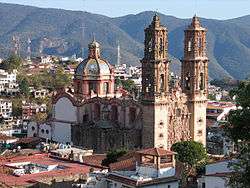Church of Santa Prisca de Taxco
The Parroquia de Santa Prisca y San Sebastían, commonly known as the Church of Santa Prisca, is a colonial monument located in the city of Taxco de Alarcón, in the southern state of Guerrero, Mexico, built between 1751 and 1758. It is located on the east side of the main plaza of Taxco.[1]
| Church of Santa Prisca de Taxco | |
|---|---|
.jpg) Church of Santa Prisca de Taxco bell towers | |

| |
| Location | Taxco |
| Country | Mexico |
| Denomination | Roman Catholic Church |
| History | |
| Founded | 1758 |
| Architecture | |
| Style | New Spanish Baroque |
| Specifications | |
| Materials | Stone |

The construction was ordered by José de la Borda, one of the most prosperous mine owners of the region of Taxco in the 18th century. From 1758 to 1806, the temple was the tallest building in Mexico, but was surpassed by the Church of Our Lady of Mount Carmel in San Luis Potosí City.
Construction
The church was built between 1751 and 1758 by José de la Borda (ca. 1700–1778), who had made a great fortune in the silver mines surrounding the town. Despite his wealth, however, the opulence of the church nearly bankrupted him.[2] The construction of the church of Santa Prisca in Taxco lasted 15 years and was aimed at creating a space where the priest Manuel de la Borda--son of José de la Borda, benefactor and founder of the parish--could officiate mass. The architectural design was provided by the French architect Diego Durán and the Spanish Cayetano Sigüenza. The altars are work also of the Spanish Isidro Vicente and Luis de Balbás.

Description
.jpg)
The parish is located in a small ravine to the west of the old city of Taxco. It has a Latin cross plan, with an aisle chapel which serves as the altar of the souls. It has Churrigueresque twin towers and a chapel decorated with Talavera tiles, typical of New Spanish architecture. The church is narrower than most due to the lack of flat land on which to build in the area.[3] It is built with pink stone, flanked by two towers which are plain in the lower half but highly decorated in the upper bell portions. The crown overlooking the main portal has a representation of the Assumption of Mary.[1] The cupola is covered in colored tile.[3]
Inside, there are nine floor-to-ceiling altarpieces, all covered in gold. The main altarpiece is dedicated to the church’s two patron saints, Santa Prisca and San Sebastian.[1] In the chapels of the transept of the church are two other important altarpieces, one dedicated to the Virgin of Guadalupe and the other to the Virgin of Rosary.
Inside the church are paintings by Miguel Cabrera, called "the divine," a Oaxacan painter born in the 17th century, who was commissioned by José de la Borda to decorate the building.
Restoration
Vibrations from blasts in nearby mining operations, earthquakes, and automobile traffic caused cracks in Santa Prisca’s vaults, and a restoration project began in 1997. To help the restoration project be carried to completion, the World Monuments Fund listed the church in the 2000 World Monuments Watch and provided funding from American Express and the Robert W. Wilson Challenge to Conserve Our Heritage for the conservation of walls, vaults, and the sacristy of the church.[4]
Legend of Santa Prisca
There is a legend associated with the Santa Prisca Church. While it was in construction, José de la Borda left Taxco on business to Guanajuato, leaving construction work to the builders. Soon after Borda left, the sky filled with black clouds and cold winds struck the streets, whistling through the towers of the unfinished church. The dark and cold terrified the workmen as the large storm approached. Suddenly a large bolt of lightning struck showing an undefined black silhouette that was swooping down on the church. Then it struck the cupola of the church, lighting it brilliantly. All of the tile covering the cupola began to shine with strange lights, allowing the inscription “Gloria a Dios en las alturas y paz en la tierra a los hombres de buena voluntad” (Glory to God in the Highest and peace on earth for men with good will) to be seen clearly. The whole town got down on their knees to pray, fearing that angry demons would destroy the church. Floating around the church were flashes of light and above the church appeared a beautiful woman who, smiling and with a peaceful face, caught the following lightning bolts in her hands.[5]
See also
References
| Wikimedia Commons has media related to Santa Prisca Church (Taxco de Alarcón). |
- "El brillo de Taxco". Mexico Desconocido Guerrero El Destino del Mundo (in Spanish). Mexico City: Grupo Editorial Impresiones Aéreas. 135: 77–84. May 2007. ISSN 0188-5146.
- Allen, Jim; Jan McHargue. "Silver, Saints, and Sinners: Semana Santa in Taxco, Mexico". Mexconnect. Retrieved 2009-08-26.
- Valtierra, Angel. "Fin de Semana in Taxco" (in Spanish). Mexico Desconocido. Archived from the original on 2010-03-10. Retrieved 2009-08-26.
- World Monuments Fund - Santa Prisca Parish Church
- "Enciclopedia de los Municipios de Mexico-Guerrero:Taxco de Alarcón" (in Spanish). Retrieved 2009-08-26.